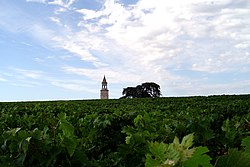Haut-Médoc AOC
| Wine region | |
 |
|
| Type | Appellation d'origine contrôlée |
|---|---|
| Year established | 1936 |
| Country | France |
| Part of | Bordeaux Left Bank, Médoc AOC |
| Sub-regions | Margaux AOC, Listrac-Médoc AOC, Moulis-en-Médoc AOC, Saint-Julien AOC, Pauillac AOC, Saint-Estèphe AOC |
| Climate region | Oceanic climate |
| Soil conditions | gravel, chalk, clay |
| Total area | 4,657 ha (11,510 acres) |
| No. of vineyards | 392 |
| Grapes produced | Cabernet Sauvignon, Merlot, Petit Verdot, Malbec, Cabernet Franc, Carménère |
| Wine produced | 32,600,000 bottles 217,656 hl (5,749,900 US gal) |
Haut-Médoc (French: [o medɔk]) is an Appellation d'Origine Contrôlée (AOC) for wine in the Bordeaux wine region of southwestern France, on the Left Bank of the Gironde estuary. Covering a large part of the viticultural strip of land along the Médoc peninsula, the zone covers approximately 60 kilometres (37 mi) of its length.
As defined by the original Institut National des Appellations d'Origine (INAO) decree of November 14, 1936, its southern edge borders the city of Bordeaux and the Médoc AOC to the north, encompassing fifteen communes exclusive to the appellation, while at the same time it enclaves six appellations made up of nine communes (Margaux AOC, Listrac-Médoc AOC, Moulis-en-Médoc AOC, Saint-Julien AOC, Pauillac AOC and Saint-Estèphe AOC) that are technically wine-making communes of Haut-Médoc. Similarly, Haut-Médoc is a sub-appellation of the Médoc AOC.
Of Haut-Médoc's fifteen wine-producing communes, eight are located along the waterfront of Garonne and Gironde: Blanquefort, Parempuyre, Ludon, Macau, Arcins, Lamarque, Cussac and Saint-Seurin-de-Cadourne. Seven communes lie inland: Le Taillan, Le Pian-Médoc, Avensan, Saint-Laurent-Médoc. Saint-Sauveur, Cissac and Vertheuil.
...
Wikipedia
